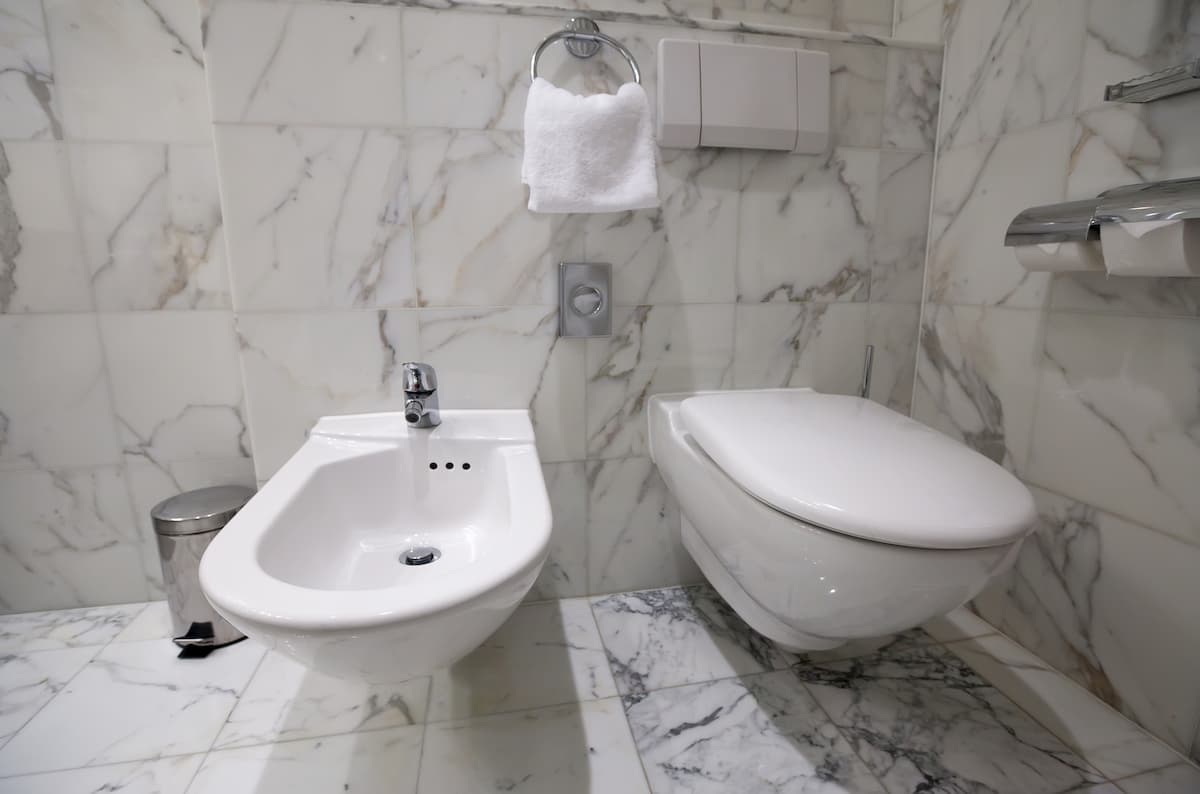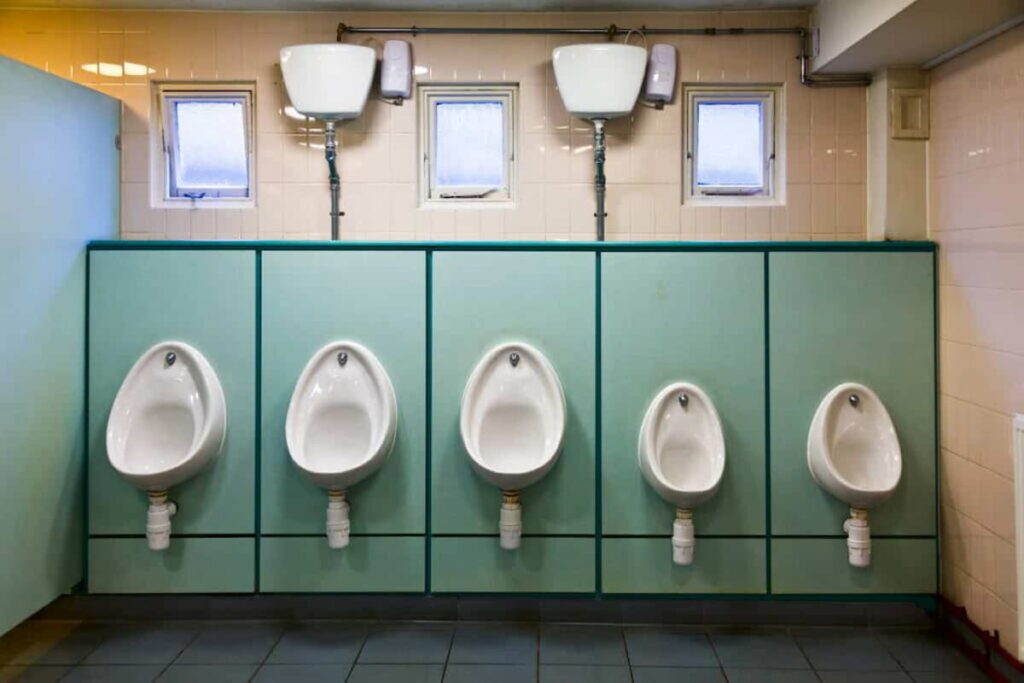Toilets in Spain: A Guide to Public Restrooms for Travelers

If you’re planning a trip to Spain, you might be curious about something not often talked about: the toilets. From the bidets in hotel bathrooms to the varying quality of public restrooms, there’s quite a bit to know.
I’ve been living in Spain for a while now, and can confirm that you’ll definitely find the full range of bathrooms here in terms of their facilities, availability and more. Stick with me, and I’ll give you the lowdown on what to expect from the toilets in Spain, so you’re ready for anything on your travels!
Why Does Spain Have Two Toilets?
In many homes in Spain, you often find what looks like two toilets in a bathroom. They’re not, though – one is a regular toilet, and the other, smaller unit is a bidet. The bidet is a common bathroom fixture in Spain and is used for additional cleaning after using the toilet.
The regular toilet is the standard fixture in any bathroom, used for, well, what they’re used for. On the other hand, the bidet looks like a small, low sink with a faucet that points upwards and is designed to help you clean yourself with water after using the toilet.

Though it may be confusing at first, the presence of both fixtures is grounded in cultural preferences. For many Spaniards, the bidet offers a water-based cleaning method that some people find more thorough than toilet paper alone.
In terms of usage, here’s what you generally do:
- Use the regular toilet as you normally would.
- After finishing, move over to the bidet.
- Turn on the tap and adjust the water temperature.
- Use your hand to direct the water for cleansing.
Remember, the bidet isn’t there to replace toilet paper – it’s typically used afterwards for an extra level of clean.
You might also find that the bidet can come in handy for other purposes, like rinsing off dirty footwear or giving a small pet a bath… or, in the case of my household apparently, putting dirty clothes until someone – i.e. me – moves them to where they’re actually supposed to be.
What is Spanish Toilet Etiquette?
In Spain, like anywhere, good manners and respecting local customs even extend to the bathroom. It’s important to know what’s expected to avoid any awkward situations. When visiting a Spanish home or public restroom, you’ll find that cleanliness and consideration for the next user are highly valued – again, like anywhere, really.
There are a few things to keep in mind though, especially when using a public bathroom:
- Sometimes bars and restaurants may ask you not to flush toilet paper and to instead put it in a basket or trash can next to the toilet. This is due to what is often very old plumbing that can’t handle additional items being flushed. Yes, I still find it weird too.
- You don’t typically have to pay to use public bathrooms, especially not those in bars and restaurants. While you do see it from time to time in public restrooms that aren’t attached to a dining establishment, it’s not as wide spread as in other European countries.
- In fact, if you’re a customer, you legally cannot be charged to use a bathroom in a bar or restaurant.
- You can usually use a bathroom somewhere even if you’re not a customer although it’s arguably not good manners and I’m personally not a fan of this – but if you just quickly duck in, no one will usually say anything.
- Public bathrooms at gas stations are remarkably clean – more so than you’ll find in many bars and restaurants, I have to say, which can be…fairly mixed, in terms of maintenance.
- Public restrooms in tourist-heavy areas are likely not going to be very well maintained. This is perhaps more from my personal experience, but I haven’t been overly impressed with the cleanliness of many of these in Spain – although this is likely true in most areas that get a lot of foot traffic. But if you can wait, try to hold on until you’re a bit off the beaten track or at your next meal, so you can use the restroom there.
Basically, you’ll find that basic bathroom etiquette in Spain isn’t drastically different from many other places. Remember to be considerate, hygienic, and when in doubt, mimic what locals do.
Do You Put Toilet Paper in the Toilet in Spain?
Yes, in Spain, you can typically put toilet paper in the toilet. The plumbing systems in most urban and modern areas are equipped to handle this. However, there are exceptions where you might find signs asking you not to do so, especially in bars and restaurants in older buildings.
That is, in certain older buildings, rural areas, or places with sensitive plumbing, the infrastructure may not be able to process toilet paper effectively. In these cases, it’s common to find a small bin beside the toilet where you should dispose of the used paper.

Do You Have to Pay to Use Toilets in Spain?
In Spain, some public toilets charge a fee. This is a common practice in tourist areas but less so in local neighborhoods. It’s a small amount, usually ranging from 20 to 50 cents.
Public facilities that charge are often found in bus and train stations, shopping centers, and near popular attractions. They’re typically kept clean and well-stocked, offering a comfortable restroom experience.
In contrast, free toilets are available in places like restaurants, cafes, or bars, but they’re usually intended for customers. It’s common courtesy to buy something before using these facilities.
Make sure to have some coins with you, especially if you’re planning a day out in tourist-heavy locations. Going into a café and grabbing a coffee could also give you access to their facilities.
Another tip: Carrying a pack of tissues is wise as not all facilities will have toilet paper, even the pay-to-use ones.
Why Do You Have to Pay for Toilets in Spain?
Paying for toilet access in Spain is a common practice. It’s viewed as a way to maintain cleanliness and ensure the availability of facilities. When you pay to use a toilet, you’re contributing toward their upkeep.
By charging a fee, the maintenance cost is covered. Restrooms, especially in tourist-heavy areas, see a lot of wear and tear, so the fees help manage this.
The concept can be unfamiliar if you’re from a place where public toilets are typically free. However, carrying some small change can ensure that you’re not caught off-guard when you need to go.
Many travelers find that the quality and cleanliness of pay toilets are worth the minor expense.
How Do You Ask for a Toilet in Spain?
In Spain, if you need to find a toilet, you can ask “¿Dónde está el baño?” which translates to “Where is the bathroom?” You might also use “¿Dónde está el aseo?” if you’re looking for a public washroom. There are, however, usually signs.
Remember that in Spain, it’s common to find toilets in bars, restaurants, and public places like malls and train stations. It’s considered polite to make a small purchase when using the facilities in a small establishment like a cafe.
Also, keep in mind that toilets in Spain are often labeled like this:
- WC – An abbreviation for “water closet.”
- Mujeres – Indicates a women’s toilet (often just shown with “M”).
- Hombres – Indicates a men’s toilet (often just shown with “H”).
One funny quirk for English speakers to keep in mind is that if you see “M” on the restroom door, you may be tempted to think it means “Men”. In Spanish, it actually signifies “mujeres” or “women” – so be careful which door you open!

How Common Are Bidets in Spain?
Bidets are quite common in Spain, and you’ll often find them in both private homes and hotels. They’re considered a staple in many Spanish bathrooms, even if not everyone actually uses them these days. Nevertheless, if you’re visiting Spain, it’s likely you’ll encounter one.
Traditionally, bidets have been used in Spain for generations as a means of personal hygiene. While the prevalence of bidets in Spanish homes is not uniformly quantifiable, it’s safe to say that they are more common in Spain than in many other European countries.
Bidets even continue to be installed in new residential constructions, although the trend shows some decline with modern minimalist design preferences.
That said, bidets aren’t typically found in public restrooms, with such amenities reserved for private spaces.
Does Spain Have Public Toilets?
Yes, Spain does have public toilets. They’re typically found in popular tourist areas, transport hubs, and parks. However, the number and condition can vary greatly between locations.
In major cities, you’ll generally find public restrooms in larger public squares, near landmarks, and in railway and bus stations. Shopping malls and department stores also offer facilities that are usually well-maintained, and you can access them without making a purchase.
It’s worth noting that these restrooms are usually clearly signposted with the internationally recognized symbols.
Finding restrooms in smaller towns might be more challenging. Often, your best option is to visit a café or bar.
While it’s courteous to buy something, many establishments understand the need and may allow you to use the facilities. In rural areas, public restrooms are less common, and planning ahead is advisable.
Certain public events or local festivals might set up temporary facilities to accommodate the increased number of visitors. These are usually portable toilets and may vary in cleanliness.
Always carry a small amount of change, as some public toilets may charge a small fee or have an attendant tipping is customary.
What Are Public Toilets Called in Spain?
In Spain, public toilets are often referred to as “aseos.” This term is widely recognized and used when you’re looking for restrooms in various public places. They’re also called “servicios” or “baños públicos,” depending on the context and region.
Key Terminology:
- Aseos: The most common term for public toilets, appearing on signage in airports, train stations, and restaurants.
- Servicios: Another term used interchangeably with “aseos.”
- Baños Públicos: Literally translates to public baths, but it’s another way to reference public toilets.

Do Supermarkets in Spain Have Bathrooms?
Most supermarkets in Spain have bathrooms for customer use. They’re typically located at the back of the store or near the entrance. Sometimes you might need to ask a staff member for a key or a code.
These facilities are usually maintained to a standard suitable for public use, but their cleanliness can vary depending on the location and the time of day.
In larger supermarket chains, bathrooms are more common and often easier to locate. Smaller shops might not always have facilities available for customers, so it’s advisable to check in advance if this is important for your visit.
Do Petrol Stations Have Toilets in Spain?
Yes, most petrol stations in Spain have toilets. They are usually free to use for customers (and even non-customers in many places) although you usually have to ask for a key to access them. It’s important to note that cleanliness can vary from one place to another.
When you’re traveling in Spain and you need to use the toilet, petrol stations are a viable option.
That said, I’d suggest that you carry your own tissue or wipes as they might not be provided. You should also be prepared for the fact that some rural or less frequented stations may have more basic facilities.
Remember, petrol stations are just one option. Restaurants, cafes, and shopping centers also offer public restrooms which might be more comfortable, especially if you’re looking for accessible facilities or baby changing areas.
